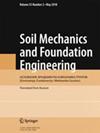利用 XFEM 在岩体中进行水力压裂传播
IF 0.6
4区 工程技术
Q4 ENGINEERING, GEOLOGICAL
引用次数: 0
摘要
本文采用扩展有限元法(XFEM)对岩体中的水力裂缝传播进行建模。在所提出的算法中,XFEM 框架与流体流动和岩石变形模型完全耦合。裂缝内的流体被视为不可压缩的牛顿流体。在所提出的公式中,裂缝周围的节点使用一阶广义形状函数,并使用增强拉格朗日法结合砂浆法(段对段)来处理两个裂缝面的接触。研究了自然断裂情况下的裂缝宽度、裂缝长度和裂缝中的压力。本文章由计算机程序翻译,如有差异,请以英文原文为准。
Hydraulic Fracture Propagation in Rock Mass with XFEM
Modeling hydraulic fracture propagation in rock mass within the extended finite element method (XFEM) is presented in this paper. The XFEM framework is integrated by fully coupling the model with fluid flow and rock deformation in the proposed algorithm. The fluid within the fracture is considered as an incompressible Newtonian fluid. In the proposed formulation, the first-order generalized shape functions for the nodes around the cracks are used, and the augmented Lagrange method combined with the mortar method (segment to segment) is used to treat the contact of the two cracks faces. The crack width, the crack length, and the pressure in the crack in the presence of a natural fracture are studied.
求助全文
通过发布文献求助,成功后即可免费获取论文全文。
去求助
来源期刊

Soil Mechanics and Foundation Engineering
ENGINEERING, GEOLOGICAL-
CiteScore
1.50
自引率
12.50%
发文量
65
审稿时长
6 months
期刊介绍:
Soil Mechanics and Foundation Engineering provides the Western engineer with a look at Russian advances in heavy construction techniques. Detailed contributions by experienced civil engineers offer insights into current difficulties in the field, applicable innovative solutions, and recently developed guidelines for soil analysis and foundation design.
 求助内容:
求助内容: 应助结果提醒方式:
应助结果提醒方式:


